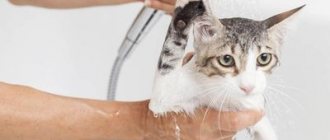Despite the fact that many representatives of the cat family are able to independently monitor the cleanliness of their fur, there is a need to wash them from time to time. For example, when a pet got dirty outside or was treated with flea and tick medications. Washing a cat at home is not as difficult as it might seem, the main thing is to follow the recommendations of felinologists.
Maintenance and hygiene of cats
The cat is characterized as a clean and tidy animal that regularly performs hygienic care for its fluffy fur.
But, due to physiological characteristics, not all parts of the body are accessible to the pet, so her beloved owner comes to her aid. It so happens that cats, by natural instinct, are very afraid of water. And if some representatives of the genus tolerate bathing procedures more loyally, others create a real problem for their owners. At the sight of a basin of water, the cat begins a real battle: it tries with all its might to escape from the person’s hands, scratches, bites and has absolutely no control over its actions.
To calm down the furious ardor of a frightened animal, one has to use physical force, which is not very correct in relation to it. Is it possible to wash a cat in a calm environment, without violent actions towards it and injuries in the form of bites and scratches on the owner?
How and with what to wash a cat if it is afraid of water and scratches
Is your cat terribly afraid of water, but, meanwhile, has been in need of washing for a long time? We will tell you how to make this easy and painless for all participants of the upcoming event.
In the bathroom
If you decide to wash your cat in the bathtub, and there is no one to help you, we recommend purchasing a special clamp in the form of a collar on a cord, at the other end of which there is a suction cup for attaching to the wall of the bathtub. The retainer does not prevent the animal from moving freely, but does not allow it to escape from the bathroom and hide somewhere. This is an indispensable remedy for those who do not want to limit the freedom of their pet, but are forced to resort to water procedures from time to time.
In the basin
A very dirty cat, which is frightened by the mere sight of water and flatly refuses to even go into the bathroom, can be washed in an ordinary plastic basin. If it is tall enough and stable enough, you can easily handle this task yourself. Otherwise, you will have to call a couple of strong fellows for help: for example, your husband and eldest son. It won’t be very comfortable for three people in the bathroom, but it will be just right around a basin standing on a stool. Let the men hold the cat and calm it down with gentle speeches, while you calmly wash it.
Using a towel
If your pet flatly refuses to bathe in water, you shouldn’t subject her to such stress every time. You can wash your cat well with a towel.
Wet it in warm water and gently rub it over the animal's fur. At the same time, follow the basic rule: move in the direction of hair growth, and not against it.
Then the cat will not experience any discomfort. This method is especially good for washing short-haired cats.
There is another way to wash an overly timid cat prone to aggression - do it with the help of a special device designed just for this purpose. A cat bathing harness is a kind of mesh bag that is secured around the animal's neck. The material for it is thick polyester. The latch reliably restrains all the movements of the restless pet, preventing it from scratching you or running away. At the same time, the mesh structure of the device is extremely convenient for soaping and rinsing the animal. With the help of a fixative, you can completely wash your pet yourself without resorting to outside help. You can buy a retainer at a pet store or order it online.
Take care of your eyes
I mean your own. An angry animal can inadvertently hurt you. Do not bring your face closer to the cat, because at any moment it can make an uncontrolled movement that can cause serious wounds. It is clear that the question of how to bathe a cat is very difficult.
If he is terribly afraid of water, try pouring water into a container first, and only then placing the animal there. The cat may be frightened by the sound of running water, so do not turn it on additionally. If you have a long-haired pet, you should comb it thoroughly before bathing.
The need to wash your pet
When kittens are born, the mother cat invariably licks them with her tongue. Cat saliva makes an excellent cleaning agent for keeping babies clean. And when the fluffy babies are close to their mother, the question of bathing them does not arise, because if you wash the kittens at an early age, the water used for this will wash away the postpartum natural lubricant that protects them from possible infections.
Water procedures are carried out for the first time when the need arises. The reasons may be as follows:
- According to the recommendations of animal owners participating in exhibitions, you can start washing a kitten from the age of one month.
- If the kitten does not participate in exhibition shows, it is separated from its mother and goes to a new home; it begins to be accustomed to water no earlier than 2-3 months, when it is already large and strong enough to endure the bathing process without colds and with less stress. You should not postpone this procedure for a long time, because after 5-6 months it will be more difficult for the kitten to get used to it.
- A small kitten picked up on the street should be bathed after entering the home environment using special products against fleas and other parasites.
- If the kitten is very dirty.
It is not worth giving water treatments to a four-legged pet unless absolutely necessary, since any shampoos for such animals (even very mild ones) negatively affect their sensitive skin.
How to bathe a kitten
A sink or basin is suitable for small kittens, as most kittens feel more comfortable in a confined space. Fill up a few centimeters of water, place a towel on the bottom to prevent the paws from slipping, and sit the kitten down. Swim with gentle movements and rinse thoroughly with water. While bathing, talk and praise the kitten. Wrap in a towel after bathing and dry the coat, place in a room without drafts and at room temperature.
It’s not a fact that after this your cat will love bathing, but it will obviously be easier to endure.
And finally: there is no need to bathe your cat often. Exhibition animals require professional grooming, while ordinary pets can easily keep their fur clean on their own. Exceptions: long-haired breeds that cannot cope with a fur coat on their own, and cases when the cat gets dirty. On average, you can bathe a cat once every 3-6 months.
Cats are afraid of water, and the process of bathing will be a serious stress for them. Nevertheless, you have to wash your furry pet periodically, especially when it comes to long-haired cats.
It is important to know how to do this correctly, with minimal consequences for your health and stress for the animal.
The fear of water is inherent in representatives of the cat family genetically, by nature itself. The fact is that the animal’s fur contains a special layer of air that has the ability to retain heat. When cats' fur gets wet, they begin to freeze.
Do not forget that a cute pet is a hunter by nature. And wet fur emits a specific, noticeable odor that can scare away potential prey.
Alternative option
If it is not possible to bathe your cat at the moment, there is another way to make him clean - dry washing. Today you can find special dry shampoos in pet stores and animal departments. The essence of this “washing” is that the owner does not need to subject his pet to an unpleasant procedure. All that is required is to apply a small amount of product to the fur and comb your pet thoroughly. This option is only suitable for those who have short-haired cats.
Thus, a caring owner should approach bathing a cat with all responsibility. It is necessary to understand that the condition of the animal largely depends on your behavior, and there is absolutely no need to make him once again nervous and anxious.
How to make friends with a cat and a hairdryer?
The most effective will be the presence of a hairdryer in the life of a new pet from infancy. This does not mean that you need to bathe him every day. It will be enough to periodically turn on the hair dryer at minimum power in the presence of the animal, sometimes closer, sometimes further from it. If the cat’s reaction is positive, it is imperative that you praise it, stroke it, give it a treat and demonstrate sincere joy with your whole appearance.
This is very important, since animals are very sensitive and easily determine the mood of the owner. A pleasant atmosphere will eradicate the cat's fear of a hair dryer
If the situation is complicated by severe trembling, meowing and other negative indicators of the cat’s condition, you should not immediately turn off the hair dryer. Thus, the animal may develop a misunderstanding of what is happening and the reflex of demonstrating hysteria to stop unwanted actions will be reinforced. In such a situation, you need to remember who is the owner and persistently, but with understanding and love for the animal, continue to take steps to accustom the cat to the hair dryer.
In adult cats and cats, the period of getting used to the hair dryer should be carried out in exactly the same way, only you need to be prepared for the fact that it will take longer.
Rules
When carrying out the procedure, a number of rules must be followed. They will help you avoid serious mistakes, stress and fear in your animal.
There are several of them:
- do not bathe the cat immediately after eating - an unusual situation for him can cause vomiting;
- You should not immerse your cat’s head in water – this will not only scare it, but will also lead to the development of diseases;
- be sure to comb your long-haired animal before the event;
- remove existing tangles if they are present - the skin under the tangle will not be washed, and the tangle itself will not go anywhere;
- follow the dosages of medications and anti-parasite shampoos to prevent the cat from being poisoned;
- You cannot scold, shout, or offend your pet while washing - this will only scare him and will not pacify his aggression.
If the rules are followed, the event will take place without risk to the health of the cat and owner.
Preparing items for bathing
Before you start bathing your animal, you need to carefully prepare for this process so that everything you need is at your fingertips. The pet will not sit and wait obediently in the bathroom while you are looking for a towel or other item.
Use the following list and prepare everything you need to wash your cat if she is afraid of water:
- A few dry towels to wrap up a shivering, wet cat after a bath. A couple of them can be laid on the floor to prevent water from spreading over the floor covering.
- Special shampoo that matches the animal's coat type.
- Two small basins for bathing. Warm water is poured into the first one and the process of cleaning the wool from dirt takes place in it, the second is intended for rinsing the wool from shampoo.
- The water poured into the basin should reach the animal’s abdomen.
- Mug or saucepan. It is used to water the cat with clean water.
- For safety reasons, prepare 2 small cotton balls - place them in your cat's ears to prevent water from getting into them. In this case, there is a higher chance that you will be able to calmly wash the cat if he is afraid of water and scratches.
- Band-aid and peroxide, in case your furry pet does scratch you.
- Before you start bathing your cat, put on a long-sleeved sweater so that the scratches are not too deep, or simply trim your pet's nails.
- If possible, call a friend for help. With the help of a friend, you'll make bath time much easier for you and your mustache.
- Hide all unnecessary jars and cosmetics. The cat may knock them over when he struggles.
Before you start bathing your cat, you need to:
- First, try to anticipate your cat's reaction to a bath and try to prepare for it. Most cats are afraid of water (see also: “Why cats are afraid of water”), therefore they can show desperate resistance to all your actions. If you are not ready for such resistance, consult your veterinarian. He will tell you how to properly dip your cat in the bath.
- Before washing your cat, carry out several preparatory measures, namely, trim the cat’s claws so that during his resistance he does not scratch you. Manually remove hairballs from your pet.
- Decide on a place for your cat to bathe. We recommend doing this in the sink or bathtub. In this case, there should be a convenient mixer so that all parts of the animal’s body can be washed without problems.
- Lay out all the necessary bathing items in a row: shampoo (suitable for the age and fur of the cat), necessary medications for the animal, a washcloth (for cleaning the head and face), a soft towel (to dry the pet), protective clothing (which will protect you from bites and scratches).
- Call an assistant. One pair of hands is sometimes not enough to pacify and calm the animal. Call a friend or acquaintance to help you wash your cat.
- Prepare the water. It should not be too cold or, on the contrary, too hot. To do this, add some water to the bathtub or sink and check its temperature with your hand.
Special shampoos
How to wash a cat without damaging its eyes? When it’s the face’s turn, you will need “No Tears” kitten shampoo. As a last resort, if it is not at hand, use a children's analogue.
It's time to apply the color intensifying shampoo. Today, such products are available for sale for all colors. It is recommended to use only those that will enhance the natural color of the coat, and not artificially color it. Then the shampoo should be rinsed off thoroughly. Finally, apply conditioner, leave it on the coat for 2-3 minutes and rinse thoroughly. The procedure is completed. Now you know how to wash a cat. It remains to be seen what to do with him next.
When does a cat need a bath?
Many people believe that cats are good at maintaining their personal hygiene on their own because they spend a lot of time licking their fur. It’s really not worth washing your cat every week just to keep its fur smooth and silky. Cat fur is covered with a special lubricant produced by the sebaceous glands. Bathing with shampoo washes away this lubricant, and the natural protection disappears.
Pollution
If the animal is dirty and the contaminated area is large enough, you will have to carry out a bath procedure. Cats love to explore everything around them and can find adventures in their fur - without even leaving the apartment.
Minor dirt can be wiped off with a napkin or a damp cloth - and without washing. Also, do not expose your pet to stress after walks - just wipe his paws if he steps in a puddle.
Before the exhibition
In order for the jury to appreciate your pet, it should be brought into appropriate shape. Usually the cat is taken to a grooming salon, where a specialist does a complete “maraffe”, but some owners cope with this task themselves.
An exhibition animal must be accustomed to complex hygienic procedures from childhood. Otherwise, it will be very difficult to bring it into a decent appearance.
Washing before a show should include cleansing the coat, applying balms, conditioners, oils and powders. Afterwards - thorough combing.
Scheduled cleanliness
The dirt that you bring into the house on your shoes remains in your pet’s undercoat, and by licking it, the cat can harm its body. Therefore, preventive bathing is still necessary.
If your pet is not noticeably dirty, you can wash it no more than several times a year.
Therapeutic bathing (against parasites)
After the cat has been treated for ticks and fleas, it needs to be washed - unless there are contraindications in the instructions included with the drug. Another option is to use insecticidal shampoos. They are a good protection against fleas in cases where the cat accepts bath procedures normally.
Preparation rules
The bathing process can be divided into 3 stages:
- preparation;
- bathing;
- drying
When caring for your cat, you will definitely need a furminator.
Baths
You should remove all hanging towels in the bathroom, because if the cat breaks out, he will cling to them, tear them, pull out the ties, and throw them to the floor.
You also need to put away soap dishes, shampoos, washcloths - everything that can get under the pussy's paw. It is better to bathe the animal in a bathtub with a terry towel or rubber mat placed at the bottom so that its paws do not slip along the bottom.
For a small kitten, the size of the bath will be large and will cause fear, so it must be placed in a bowl or in a sink. Since a cat’s body temperature is 38–39 °C, a comfortable water temperature for her will be 38–40 °C. The air temperature in the bathroom should not be lower than 15 °C.
Water must be collected in advance so that its noise does not frighten the mustachioed one. Its volume should be so large that it reaches the animal’s abdomen—approximately 15–20 cm.
Important! Shampoo for bathing a cat must be purchased specially, taking into account the characteristics of its fur. You should not wash it with soap, as it dries out the skin.
Kota
Before you wash your cat in the bathroom, his claws need to be trimmed.
Find out how to make your own cat scratching post.
The animal should be bathed after visiting the tray.
After all the preparatory procedures, you can already start swimming.
How to wash a cat if she is afraid of water
Many owners get injured while bathing their pet because they do it incorrectly.
Some experts believe that cats are not afraid of water, but are afraid of drowning. Therefore, they get very nervous, break out and meow.
Experts advise performing the following manipulations:
- first, find yourself a partner: one person should hold the pet, and the second should soap it;
- refuse to fill the bathtub, it is better to use a basin and a bathtub, you need to prepare a towel in advance;
- Do not turn on the shower under any circumstances: the noise of the water can frighten the animal;
- using a ladle or other container, wet the cat's fur and lather it, but this must be done slowly, with measured movements;
- For bathing, you can use only shampoos specially produced for animals, and cats do not need balms and conditioners at all;
- water should not get into the eyes, nose, mouth and ears (the latter can be plugged with cotton wool for safety);
- monitor the water temperature - 30-38 degrees;
- during the procedure, try to calm the animal, talk to it;
- wash off the foam using a ladle;
- do not make sudden movements yourself and under no circumstances raise your voice at your pet;
- After bathing procedures, wrap your pet in a towel.
After bathing, the animal must be calmed down. For example, stroke your pet's fur or hold it in your arms.
Food is a tranquilizer of unpleasant emotions, so be sure to give your pet something tasty.
By the way, cat breeds such as May Coons and Chauses are not at all afraid of water.
However, many have noticed that quite often cats look fascinated at the water in a full bath or like to lie in it.
As animal psychologists explain, cats are curious animals; they carefully study an unfamiliar space.
Sometimes the animal itself jumps into the bathtub with water, at this moment it is just possible to wash the pet.
The sooner you introduce your pet to the bath, the faster he will get used to it.
Very important! Veterinarians do not allow pets to be bathed before three months.
The pet may not tolerate much stress or become seriously ill.
In addition, make sure that there is little water, and the pet can stand on the surface without slipping, in this case there will be less fear in the eyes.
Pour just a little water and try to throw the cat into the “pond”, then start talking to him, playing, and performing distracting actions.
If your cat bravely endured an unpleasant procedure, do not ruin the situation by drying it.
After bathing, the cat must lick itself or shake itself off. It is better not to dry it with a hairdryer - additional stress for the animal.
Close all windows in the house to avoid drafts, otherwise the risk of serious illness triples, and wrap your pet in a towel.
Can all cats swim?
Despite the fact that cats prefer not to get involved with the water element, they are excellent swimmers from birth. Absolutely all representatives of the cat family can cover a considerable distance by water. Of course, this does not apply to newborn kittens, who do not have enough control over their bodies to be able to escape if they fall into the water. But already one month old kittens, if lowered to a sufficient depth, will work with their paws, scooping up water.
The ability to swim is an innate instinct of cats
All cats need swimming skills, as do any animals that go hunting. In case the mustachioed animal finds itself in a flood zone, drives its prey to a reservoir, or, on the contrary, the pursuing hunter drives it to the water, the animal is always ready to swim to save its life.
To wash or not to wash
On one side of the issue is nature - free cats do not swim, and it would seem that they do not need water treatments. On the other hand, there is the issue of hygiene. Murka faces many dangers in the form of all kinds of fleas and ticks, so preventing such troubles is a necessary measure.
Veterinarians say: bathing pets is not a whim, it is a necessity. Of course, you should not abuse water procedures. Even if you manage to instill in your mustache a love of water, excessive bathing can harm your pet. But it is advisable to plan to dip the murka in water.
Some owners are ready to defend the rights of their pet. Based on natural instincts, “caring” owners prefer not to bathe their pets. Of course, water treatments for animals are not the most pleasant. However, being responsible for those they have tamed, owners must be aware of the importance of conducting such events. Even if friendship with an animal is at stake.
To bathe or not to bathe a cat? The question is philosophical. Let's consider the advantages of water procedures.
What is needed to bathe a cat?
In order to wash your cat, you need to prepare everything you need in advance. Let's look at the list of things needed for hygiene procedures with your pet.
Shampoo
It is very important to choose the appropriate shampoo for bathing your cat, which will be adapted to his needs and can provide the necessary care for his fur. It is worth choosing a shampoo responsibly, taking into account the breed, coat characteristics and possible problems of the pet.
You should never use your own shampoo - this can harm your pet and cause an allergic reaction in some cases. Buy cat shampoo in specialized stores, where there is a guarantee that you will not be sold a counterfeit or low-quality product.
In addition to degreasing shampoo, a special paste is also used for long-haired cats, which is applied to those places that get dirty the most, and only then shampoo is used.
It is also worth knowing that there are several types of specialized shampoos for bathing cats. Let's look at the two most popular ones.
- Degreasing shampoo. This shampoo is used for basic cat care, regardless of its breed and characteristics. It is applied to the cat’s damp fur or after using a special degreasing paste.
- There are also texturer shampoos for cats. Shampoos of this type are used after complete degreasing of the coat in order to give it volume, shine and make combing easier (which is most important for long-haired cats).
In addition, various tinting shampoos and conditioners are also used, which are used most often for show cats, for which appearance is very important.
But, in addition to the benefits, such shampoos also have side effects, which is why they are not recommended for basic pet care and frequent hygiene procedures.
Massage mitten.
Very often, pet owners neglect to purchase this important accessory, which makes hygiene procedures easier for cats and makes bathing more effective. In fact, a massage mitten helps to clean your pet’s fur much more effectively and better.
This accessory is used for applying and carefully distributing shampoos and other care products over the cat's fur.
In addition, the massage mitten helps improve blood supply to the hair follicles, which makes the pet’s coat healthier, stronger and silkier. Therefore, if you want to make hygiene procedures for your cat not only more pleasant, but also effective, buy yourself a massage mitten.
Clamp with silicone suction cup.
The invention appeared relatively recently, but has already begun to be in demand in pet stores and is loved by pet owners. This very simple addition will help you make hygiene procedures faster and eliminate the need to catch your obstinate pet throughout the apartment.
After all, not every cat loves water and gladly indulges in all hygienic manipulations - such pets are rather the exception. Therefore, with such a clamp it will be much easier for you.
This device is a collar for a cat, to which is attached a cord, at the end of which there is a silicone suction cup that clings to the bathtub. Thus, the restrained cat has freedom of movement, but cannot escape from the bathroom.
Towels.
In principle, you probably guessed this yourself - after bathing the cat you will need to dry it with something. It's elementary
But it is very important that the towels you use to dry your cat are completely natural and absorb water well.
It is better to use two towels for bathing - remember that your goal is to restore thermoregulation processes as soon as possible after bathing.
Hygiene products for kittens
Before you wash your baby for the first time, you need to choose a detergent for him. The choice of these drugs in pet stores is quite large, but when buying shampoo for your pet, you should consider the following nuances:
- Any, even neutral, soft human shampoos and soaps used for children and allergy sufferers are not suitable for either kittens or adult cats due to differences in the acid-base balance. These household chemicals can have a negative impact on the animal.
- Shampoos intended for puppies and adult dogs, rabbits and other pets should not be used to wash such babies.
- Shampoos are not used for adult cats, since babies’ eyes, mucous membranes and skin are more sensitive and do not have sufficient natural protection.
There are special types of shampoos for kittens. Among them:
Liquid. With their help, the animal's fur becomes soft and silky. A small amount of this product is required for one application, as it produces a lot of foam, which is difficult to wash off. Dry. When a small pet is very afraid of water, you can wash the kitten with dry shampoo (powder). This is a good way out of the situation, and although it will not be able to accustom the baby to water, such a remedy should be used in case of panic. It cleanses the animal's fur no worse than conventional liquid shampoos. It is applied to the pet’s dry skin, and then combed out of the fur along with the dirt using a comb. These shampoos are used for kittens older than 3 months. Shampoo sprays. They are applied to the animal’s wet fur and dry out the skin to a lesser extent.
This is especially important for pets under six months old.
For purebred babies, special shampoos are purchased. Such products are developed taking into account the characteristics of kittens’ fur, immunity and other indicators. The composition of shampoo for Sphynx cats, for example, will be different from shampoo for British cats. It is not necessary to choose such a detergent for a specific breed, but it is advisable.
You should know that special shampoos used for kittens are quite expensive. And in order not to save on your pet’s health, you can choose domestic products that are not inferior in quality to imported ones. In addition, shampoos for kittens can be sold in small bottles, which are cheaper than large bottles.
Rules for washing pets
Handle your pet carefully during the procedure. Do not throw your pet into the bathtub. Try not to hold forcibly. Avoid getting water in your ears, as... this can trigger the development of diseases.
When swimming you need to do the following:
- Prepare in advance. During the washing process, you will not have the opportunity to go to the next room for shampoo or a towel, so immediately take everything you need with you. It is advisable to ask an assistant to hold the cat so that you can do the actual bathing. Before hygiene procedures, it is better to trim the animal’s claws. This minimizes the risk of injury.
- Start swimming. Adjust the temperature. Place a net or towel on the bottom to prevent your pet from slipping. Place the animal on its paws and wait. If you are using a restraint, just let your cat stand there for a few seconds. During this time, he will understand that nothing threatens him. If you have not restrained the animal, caress and stroke it. Once your pet has calmed down, you can begin to wet its fur.
- Use detergents. If the wool is clean, you can skip this step. It is better to distribute the shampoo with a massage brush. Special products do not foam; they are kept on the wool for some time, then washed off. It is best to minimize contact with shampoos if possible, because... For cats, washing is an unnatural process. This causes them stress.
- Rinse off the shampoo. Residues must be removed carefully, otherwise they will irritate the skin and cause itching. If you use not only shampoos, but also conditioners, rinse them thoroughly each time. Multiple products may cause an unwanted chemical reaction when combined.
- Dry the wool. It's better to do this without a hairdryer. You can wrap your cat in a towel and hold him in your arms for a few minutes. During this time, most of the moisture will be absorbed by the fabric. After this, you can lower the cat to the floor, take another dry towel and begin to remove any remaining water.
- Comb the fur. It is better to start the last stage after the pet has calmed down. This step can be skipped if the animal does not shed, but for breeds such as Britons and Scottish Folds, it is required. They have a dense, stuffed coat that constantly sheds.
Where to swim
Another important preparation point is choosing a place to bathe your cat.
Bath
Maximum conditions and ease of washing are in the bathroom, using a shower.
Among the obvious advantages:
- unlimited amount of water used;
- water pressure adjustment;
- temperature selection;
- Mobility of the shower head for thorough cleaning.
However, it is the soul that cats fear most: it creates noise that frightens them. It is preferable to turn the shower head on to the “soft” jet mode.
How to properly cut and shave a cat
Why do cats go bald?
Furminator
Basin
A cat is exposed to less stress when bathing in a basin. The absence of sharp loud sounds and a calm environment predispose her to the procedure.
Bathing a cat in a basin is associated with a number of inconveniences for the owner:
- the need to water the animal with a ladle;
- frequent water changes.
During the washing process, the pet will catch its paws on the edges of the container, which may cause the basin to tip over. This will frighten the animal and lead to additional cleaning.











